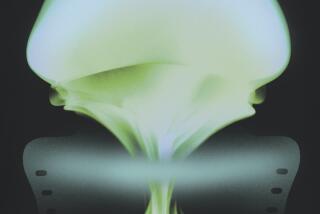A restless killer radiates intrigue
The poisoning death of Alexander Litvinenko in November caused by the radioactive isotope polonium-210 sparked a sharp interest in the exotic material, but the onetime Russian spy was not the first to swallow the lethal element.
At the height of World War II, in an isolated medical ward at the University of Rochester in New York, Dr. Robert M. Fink gave water laced with polonium-210 to a terminal cancer patient and injected four others with the isotope. None of the five apparently died from the minute doses, though one succumbed to his cancer six days later.
The ethically dubious experiment, prompted by concern for the safety of workers in the Manhattan Project to develop the atomic bomb, yielded the first solid information about the isotope’s health effects on humans.
It also underscores the mystery and intrigue that have marked the history of the element since it was discovered by Marie and Pierre Curie a century ago. The isotope has left a distinctive trail of deaths, most of them a consequence of ignorance.
Although scientists suspected polonium-210 was dangerous, they failed to appreciate how easily it could spread -- escaping laboratory confinement like a genie from a bottle and spreading its lethal radiation on faint currents of air.
Engineers have struggled to find a use for the isotope, incorporating it for a time in spark plugs, nuclear warhead triggers and spacecraft power supplies. It plays a small role today as an antistatic agent for printing presses.
Assassins may have finally hit on its most effective use.
“The scientific community is intrigued” by Litvinenko’s slaying, said radiation biologist David A. Dooley, who studied exposure levels in workers who produced polonium for the Manhattan Project. “It’s pretty clever they came up with this.”
In many ways, polonium-210 is an ideal poison for espionage -- deadly, and undetectable until it’s too late.
A dose of the white powder smaller than a grain of salt could have been dropped into Litvinenko’s drink at the Millennium Hotel’s Pine Bar in London without altering the taste, according to chemist John Emsley of Cambridge University.
Within minutes of ingestion, the energetic particles shooting off the polonium-210 molecules began killing the cells lining Litvinenko’s gastrointestinal tract. As the cells sloughed off, they caused nausea, severe internal bleeding and enormous pain.
“It was as if his internal organs received a severe sunburn and peeled,” said Peter Zimmerman, a physicist at King’s College London.
Pound for pound, polonium-210 is at least a million times more toxic than hydrogen cyanide, the poison used to execute prisoners in gas chambers, according to medical toxicology books. Radiation safety experts calculate that a single gram of polonium could kill 50 million people and sicken another 50 million.
But it is extremely hard to get. About 100 grams -- or 3 1/2 ounces -- are produced each year, primarily by Russia.
It is also elusive. Whereas most radioactive elements emit gamma rays, which register on radiation detectors, polonium-210 instead emits alpha particles.
“There was no way that forensic scientists could detect it” until it had done its damage, Emsley said.
Unlike other radioactive elements, polonium-210 is relatively safe to transport. Highly lethal gamma rays pass through most substances, but alpha particles -- each composed of two protons and two neutrons -- can be blocked by a sheet of paper or the thin layer of dead cells on the surface of the skin.
To kill, polonium must be inhaled or ingested so that it is in direct contact with healthy tissue.
“I could put it in a tiny Ziploc bag, and I would be fine,” said Dooley, president and chief executive of MJW Corp., a consulting firm in Amherst, N.Y., that specializes in radiological and health physics services.
But that doesn’t mean it’s easy to handle. Polonium-210 is a determined escape artist.
The energy produced as it naturally disintegrates is so great that “small chunks, perhaps a few hundred atoms in size, are blasted out of the surface and then drift around the room,” Zimmerman said.
“It would tend to creep around the lab,” Dooley said. “If you had polonium in an open jar and you left it overnight, the next thing you knew, it would be all over the lab. It would jump on a dust particle and end up on lab benches and floors and things.”
Since identifying polonium-210 as the poison that killed Litvinenko, investigators have found traces of it in hotel rooms, airplanes, embassy rooms and other sites in the U.S. and Europe visited by Andrei Lugovoy, a former KGB bodyguard who is considered a potential suspect in the case. Lugovoy has said he is being set up by persons unknown.
Polonium-210 is found in very low concentrations in Earth’s crust. It makes its way into plants, food and water, and occurs in trace amounts in tobacco smoke. Most people’s bodies contain about one-millionth the level of a toxic dose, said Vilma Hunt, who studied the health effects of polonium-210 at the Harvard School of Public Health.
Of polonium’s 25 isotopes, polonium-210 is the most stable. After 138 days, half of it decays into a nonradioactive isotope of lead. It takes 10 half-lives -- about three years -- for all of it to be converted into lead.
In the process, it emits a significant amount of heat. A 1-gram lump will reach more than 500 degrees Fahrenheit.
The first polonium death occurred in 1927.
The victim was Nobus Yamada, a Japanese researcher in Marie Curie’s lab in France. In 1924, he worked with Curie’s daughter Irene Joliot-Curie to prepare polonium sources. After returning home the next year, Yamada fell ill.
“There was a poisoning from the emanations,” he wrote Irene, according to Susan Quinn, author of “Marie Curie: A Life.”
Marie and Pierre Curie discovered polonium while they were searching for the cause of excess radiation in a uranium-rich ore called pitchblende. In 1898, they traced the radiation to a substance that they dubbed radium F. When Marie Curie determined that it was a unique element, she named it polonium to bring attention to the plight of her homeland, Poland, which had been partitioned among Russia, Prussia and Austria.
The Curies’ daughter Irene also fell victim to the isotope. She died of leukemia in 1956, 10 years after a sealed capsule of polonium-210 was accidentally broken in her laboratory at the Radium Institute in Paris.
About the same time, scientists developing Israel’s nuclear program were exposed to its lethal effects.
The first signs of contamination were the traces of radiation on the laboratory desk of Israeli physicist Dror Sadeh. He had taken what he thought were adequate precautions against the hyperactive element.
But those precautions weren’t enough. Radiation was discovered “in my private home, and on my hands too and on everything that I touched,” he wrote in his diary.
Within a month, one student who worked in Sadeh’s lab at the Weizmann Institute of Science in Rehovot, Israel, was dead from leukemia. The lab’s supervisor died a few years later -- contaminated by polonium-210 as well, Sadeh suspected.
As a product, polonium-210 has been mediocre at best.
Its first use was in automobile spark plugs. The alpha particles emitted during its decay helped produce a stronger spark, claimed a 1929 patent issued to J.H. Dillon of the Firestone Tire & Rubber Co.
The company began marketing the plugs in 1940, but their benefits were never proved.
Polonium-210 played a key role in World War II. Manhattan Project engineers alloyed the isotope with beryllium and used it to produce the neutrons that triggered the atomic bomb’s chain reaction.
Because of polonium’s short half-life, the nuclear triggers lost their effectiveness in two years and had to be continually replaced. By the 1970s, engineers abandoned it in favor of the hydrogen isotope tritium, with a half-life of 12.3 years.
Polonium was considered as a power source for U.S. satellites, but its short half-life again limited its utility, and plutonium was used instead. The Soviets, however, did employ polonium to keep their Lunokhod moon rovers running in the 1970s.
Engineers finally found a viable use for it in printing plants and textile mills, capitalizing on its electron-grabbing ability to neutralize the static electricity generated by moving sheets of paper or fabric. Typically, a small amount of the radioactive material is embedded in a gold foil that is placed near the sources of static electricity.
It is also used in photo labs, embedded in the bristles of cleaning brushes to counter the static electricity that causes dust to cling to pictures.
Polonium-210 could theoretically be extracted from either the foil or the brushes in a quantity sufficient to poison someone, Emsley said, but it would require a sophisticated knowledge of chemistry and a well-equipped laboratory.
Most of the research about polonium-210’s health effects stemmed from concerns for the safety of the 2,000 workers who produced the isotope for the U.S. nuclear arsenal.
To test its effects, doctors recruited terminal cancer patients who were willing to participate in radiation experiments in 1944, according to reports prepared later by the Department of Energy.
Fink and his colleagues determined that most of the polonium went into the gastrointestinal tract and was eliminated in feces. It also collected in the spleen, kidneys and liver.







